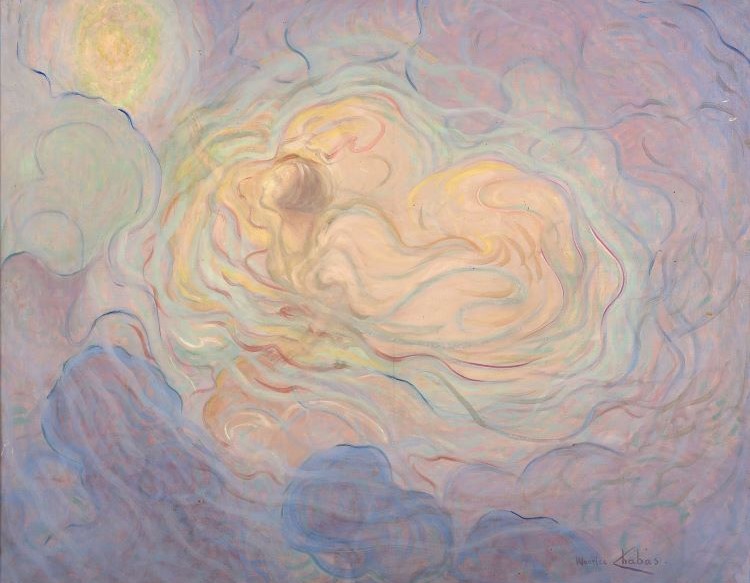by Bruno Neri and Maria Vaghi
Altered states, or non-ordinary states of consciousness (NOSC), open a window into dimensions of the mind often inaccessible in everyday life. These states can be explored both subjectively through specific contemplative practices and objectively in various scientific contexts.
They can reveal hidden aspects of our mind, lead to profound insights, and sometimes result in lasting transformations in self-perception and the perception of the world. As illustrated in the following texts, we will see how certain NOSC can be induced by meditative practices, ecstatic experiences, the use of psychoactive substances, and situations perceived as extreme for the body.
In the context of Buddhist contemplation, non-ordinary states of consciousness are considered powerful tools for understanding the nature of the mind and reality. Through meditative practices and rituals, practitioners can access non-ordinary states of consciousness, which reveal the luminous and empty nature of reality. This perspective emphasizes how meditation can lead to self-illuminating awareness, transforming one's perception and liberating from habitual patterns.
The excellent contribution of Mingyur Rinpoche discusses "ordinary mind or non-ordinary state of consciousness," relative truth, and ultimate truth, highlighting how NOSC are considered glimpses of ultimate truth, wherein the limitations of the obscured mind are transcended, revealing the luminous and empty nature of reality, which is the ordinary mind.
In this monthly in-depth exploration, the book Cave in the Snow is also mentioned, which tells the story of Jetsunma Tenzin Palmo, an English Buddhist nun who spent twelve years meditating in a cave in the Himalayas. Her story is a vivid example of how spiritual practice can lead to profoundly transformative states of consciousness. Isolated in extreme conditions, Tenzin Palmo overcame physical and mental adversities to achieve extraordinary spiritual realization. Her experience reflects the human capacity to transcend the ordinary limits of consciousness through devotion and discipline.
The scientific world also illuminates how research in neurophysiology and psychology has demonstrated that altered states of consciousness correspond to significant changes in brain activity.
In recent years, the use of psychedelic substances to induce NOSC for scientific purposes has received new impetus after being halted for several decades. Recent studies have revealed the therapeutic potential of substances like psilocybin, LSD, and MDMA in treating mental disorders such as depression, anxiety, and post-traumatic stress disorder (PTSD). Naturally, the use of these substances must be within a controlled context for therapeutic or compassionate purposes, considering that they can facilitate experiences of unity, transcendence, and deep introspection, similar to those achieved through meditation and other contemplative practices.
The ongoing dialogue and increasingly close connections between seemingly disparate fields provide fertile ground for a more integrated understanding of NOSC. In this context, Buddhist contemplative practices offer time-tested methodologies for exploring and stabilizing non-ordinary states and emphasize the importance of discipline, intention, and ethical context. They are undoubtedly ecological and practically free of adverse effects, making them often more readily applicable in scientific studies compared to psychedelics.
All this can offer a multidisciplinary overview of altered states of consciousness, combining personal experiences, spiritual teachings, and scientific research.
In the following texts, we will particularly read about Nicola De Pisapia's discussion, who, while noting the continuous presence of consciousness even during sleep, focuses specifically on the topic of lucid dreaming. This is a state in which the dreamer is aware of dreaming and can influence the experience. It has been shown that during a lucid dream, there is increased activity in the prefrontal regions of the brain, indicating awareness and cognitive control.
This area of research is very stimulating because it highlights significant potential therapeutic applications, particularly in treating nightmares and post-traumatic disorders. Therefore, the exploration of states of consciousness during sleep can offer a more comprehensive view of human consciousness and contribute to mental well-being.
In his contribution, Enrico Facco, among many other points, focuses on the definition of "altered states of consciousness" (ASC), raising a potential critique regarding the inclusion of both pathological and non-pathological states under this term. He questions whether this definition can appropriately encompass mystical experiences and deep absorption, which are certainly difficult to consider as pathologies or brain dysfunctions. For this reason, the author prefers the term Non-Ordinary Expressions of the Mind (NOME) to refer to mystical experiences, NDEs, hypnosis, meditation, and parapsychological phenomena without the prejudice of abnormality. His hope is that science maintains an open skepticism, constantly questioning the validity of its own axioms.
A recent study (May '24) on advanced meditation and absorption states focuses particularly on a systematic classification of jhānas. Traditionally associated with Buddhist monastic contexts (especially of the Theravada tradition), the jhānas are increasingly being explored today by lay practitioners as well. Therefore, this article also contributes to the study of advanced meditation.
In conclusion, exploring altered and/or non-ordinary states of consciousness is a journey towards the discovery of humanity. It is an invitation to look beyond the ordinary, to seek personal and collective enlightenment. Whether we approach these states through contemplative practice or the possibilities offered by the controlled use of psychedelics in scientific settings, the common goal is a deeper understanding of our existence and our place in the world, with the aim of reducing suffering.



